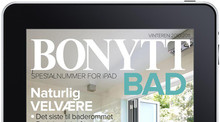 The iPad edition of Norwegian design magazine Bonytt Bad, which was praised when it launched last year for utilising the tablet's unique opportunities
The iPad edition of Norwegian design magazine Bonytt Bad, which was praised when it launched last year for utilising the tablet's unique opportunities In his opinion, the newspaper tablet app market so far, certainly in Norway where iPad and Samsung Galaxy were only launched at the end of the year, is a false market.
According to Clementz, this is because lots of media, marketing and PR professionals download media apps to see what they are like, creating an artificial market where sales figures go through the roof once a new app is launched, and then decline just as rapidly as soon as people have satisfied their curiosity with the first edition.
As WWD recently reported, iPad magazine sales are in sharp decline in many places, and French media commentator Frédéric Filloux argues media organisations have to acknowledge that the first batch of media iPad apps have simply failed. Clementz, who was involved with the first such app launched in Norway, an iPad edition of design magazine Bonytt Bad - which was praised for utilising iPad's opportunities better than many other media app - admits there are things they would have done differently today. At the time of the launch, in October, he predicted that by October 2011 we would all be laughing at the media tablet apps we were seeing in 2010. Now he says that in the company they are already laughing of some of the things they did in Bonytt Bad. At the same time he stressed that you can't just sit and wait for someone else to crack the iPad code, as by then it will be much too late to launch your own app. For my part, when I first used Bonytt Bad I was struck by an awkward dilemma.As a consumer, and one who had just moved, I loved how it allowed me to look at bathroom design, say a bath tub, from all different angles, see it in all the different colours it was available in with the touch of a button, and, at least theoretically, put me only two clicks away from actually buying it.
I found this remarkably useful as a consumer, though as a journalist I was slightly troubled by the ramifications for editorial independence.
Certainly, it removes what many feel already is a paper-thin wall between editorial and advertising, and might reduce journalists to commercial brochure writers. At the same time, I was thinking that somewhere in these kind of in-app purchases there must be a terrific business model. In this respect, there may be differences between newspaper and magazine apps, but Clementz sees this, how magazines all of a sudden can position themselves in the middle of the purchasing process, as a potentially big benefit to publishers if utilised smartly. Other things he sees as unique for what he calls tablet journalism, at least for magazines, are:- The story is not linear as in a magazine. You need to take into account that the readers are likely to jump in and out of the story at various points.
- The tablet is more visual and you need to think in storyboards.
- The designers need to be brought into the planning process from stage one. As do photographers. The format forces even closer multimedia collaboration than online journalism.
- Utilising all the opportunities the tablet offers - such as being able to show design from all angles, add a colour palette, use video or audio for interviews with experts, lost of interactive graphics etc – can create a chaotic reader experience and should be done with care.
- The reader experience must be at the centre of story- and design planning, without making the production too costly.
It demands better editorial planning. It is easy to spend a lot of resources on bells and whistles such as video and interactive graphics, but few magazines have dedicated TV- or interactive teams and you need strict editorial planning to keep costs from ballooning.
However, Clementz does not think there is one definitive tablet journalism code. Some will chose to use more data journalism, more interactive graphs, others more photos or more TV, depending on what suits the content best. But in his view, all successful iPad-development will be about utilising the opportunities tablets offer to create storytelling that is as compelling and effective as possible while trying to keep production costs to a sensible level.
Free daily newsletter
If you like our news and feature articles, you can sign up to receive our free daily (Mon-Fri) email newsletter (mobile friendly).
Related articles
- Washington Post launches smart TV app to introduce news content onto streaming devices
- Tip: What the latest iOS update means for journalists
- iPhone 6 'making the big screen the norm' for mobile publishing
- 5 news tablet apps that 'hit the spot'
- Why a Canadian newspaper invested a 'meagre' $40m in free app









